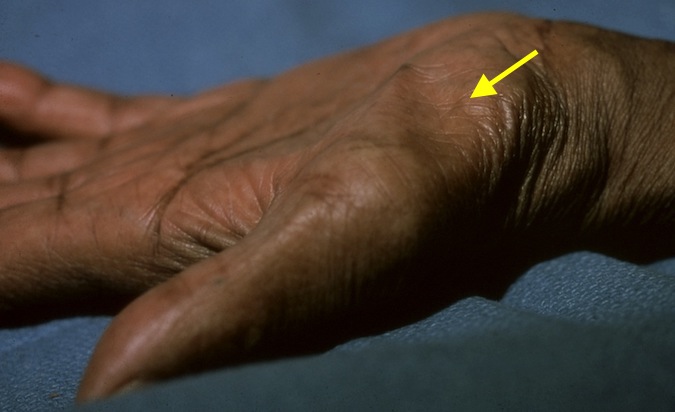Abductor Pollicis Brevis (APB) Exam
APB Muscle Data
- Origin: Scaphoid and trapezium bones, and the flexor retinaculum.
- Insertion: Lateral base of the proximal phalanx and the extensor hood of the thumb.
- Innervation: Median nerve.
- Nerve: Recurrent motor branch of the median nerve
APB Muscle Testing
When evaluating a thumb injury for signs of abductor pollicis brevis (APB) laceration, the goal is to determine whether the APB tendon is lacerated completely, partially transected, or intact. While assessing this muscle, the examiner must also recognize that isolated APB lacerations are uncommon and typically part of a thenar muscle group injury. The examination of an uninjured APB musculotendinous unit employs the 0 to 5 muscle testing grading system. Zero signifies a complete loss of abductor pollicis brevis (APB) contraction, while a grade of 5 indicates normal APB function that can contract against full resistance. A comprehensive description of graded muscle testing is available below. Full muscle testing is often not feasible in acute laceration cases due to pain and sensitivity. Nonetheless, the examiner should gently test the contraction of the potentially injured musculotendinous unit. The primary goal of the examination for an acute traumatic laceration is to determine preoperatively if the tendon is entirely cut, partially cut, or intact. To assess the APB, the patient's hand and upper extremity should be positioned with the forearm in mid-rotation and the wrist in a neutral position, with the ulnar side of the hand resting on the table. The thumb should be in a resting posture.
With the ulnar side of the patient's hand supported by the table, the examiner applies pressure with their other hand to the dorsal radial surface of the distal metacarpal of the thumb to gently resist the patient's attempt to actively abduct the thumb at the CMC joint. The examiner instructs the patient to "move your thumb away from your palm and hold it. Don't let me push it back." The resistance to abduction will vary based on the degree of injury to the APB muscle and on the discomfort caused by the examination.
Definition of Positive Result in APB Muscle Testing: A normal result is a positive one. During a normal muscle test, the examiner should observe a normal muscle contraction that can abduct the joint or tendon against full resistance.
Definition of Negative Result in APB Muscle Testing: The thenar muscles including the APB should be observed, palpated, and compared to the uninjured side. An abnormal result in muscle testing is a negative one. During a partially abnormal muscle test, the examiner should observe an abnormal muscle contraction that can move the joint or tendon but not against normal resistance. In a complete denervation injury, such as a median motor branch laceration or a complete median nerve palsy, there will be no evidence of muscle contraction, and the muscle testing grade will be zero.
In a patient with a laceration of the thenar muscles which includes the APB, the thumb CMC joint may not actively abduct normally due to a complete transection (cut) of the APB tendon or muscle and the associated tenderness. This also results in an abnormal muscle testing. However, these observations also indicate a potential complete APB laceration requiring surgical repair. Therefore, this negative muscle testing exam will be positive for a probable APB laceration.
- With the hand palm down on a flat surface, the median innervated thenar muscles are at risk for injury during a deep laceration in the area radial to the thumb metacarpal part of the dorsal section 1 (thumb) of the anatomic structures at risk.
- The flexor pollicis longus divides the thenar muscles into the group innervated by the median nerve and the ulnar nerve innervated group. The ulnar nerve innervated group includes the adductor pollicis and the deep head of the flexor pollicis brevis.
- The APB is innervated by the median nerve motor branch.
